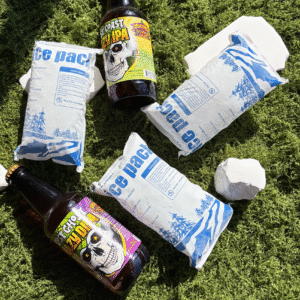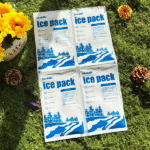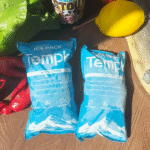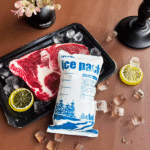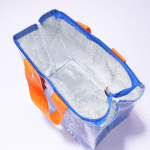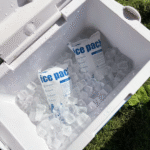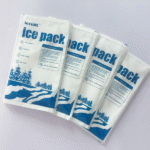Dry Ice Bag Thickness: How to Choose the Right Gauge
If you ship on dry ice, choosing the right dry ice bag thickness is the fastest way to cut punctures, pass acceptance checks, and protect payloads at −78.5 °C. For most routes, 3 mil (≈ 76 µm) hits the sweet spot; move to 4 mil (≈ 102 µm) for blocks or rough handling. This 2025 guide consolidates three expert drafts you provided into one best-practice playbook.
-
Pick a dry ice bag thickness for pellets vs. blocks without guesswork
-
Map film type (LLDPE/EVA, nylon/PE co-ex) to cold-flex and puncture resistance
-
Apply venting rules and avoid “airtight” rejections at intake
-
Convert mils ↔ microns and build a defensible SOP
Why does dry ice bag thickness matter for safety and durability?
Short answer: Thicker gauges reduce cracks and punctures at −78.5 °C and keep pellets contained, while proper venting prevents pressure build-up. In practice, most lanes succeed with 3 mil; step up to 4 mil when handling is harsh or blocks have sharp edges. Use 2 mil only as a protected inner liner.
What’s happening: Dry ice is brittle and abrasive. Standard LDPE can cold-crack when flexed. LLDPE/metallocene blends and EVA-PE films keep flexibility in freezers; nylon/PE co-ex adds puncture resistance. A thicker wall adds tear energy and helps the seal survive loading. Regulations still require a gas path, so never seal the bag airtight.
Microns vs. mils: how do I convert and choose?
Rule of thumb: 1 mil = 25.4 µm. That means 3 mil ≈ 76 µm and 4 mil ≈ 102 µm. If your spec uses microns, a practical operating window is 70–150 µm depending on film and lane abuse.
| Use Case & Risk Level | Recommended Gauge | Typical Film | What it means for you |
|---|---|---|---|
| Light pellets, protected liner | 2 mil (≈ 50 µm) | LLDPE / EVA-PE | Use only inside a rigid shipper; prioritize venting and seals |
| Standard pellets, parcel | 3 mil (≈ 76 µm) | LLDPE/EVA or nylon/PE co-ex | Best balance of cold-flex and puncture resistance |
| Blocks/shards, multi-touch | 4 mil (≈ 102 µm) | Nylon/PE co-ex or reinforced LLDPE/EVA | Handles rough corners and hub sorts with fewer film failures |
| Long-haul, high abuse | 4 mil + inner liner | Nylon/PE co-ex + 2 mil liner | Dual layers reduce rub-through and dust leakage |
Practical tips you can use today
-
If pellets cut seams: upgrade to 3 mil EVA-PE or 3 mil nylon/PE before changing the shipper.
-
If blocks scuff boxes: jump to 4 mil co-ex and add a corrugate tray under the bag.
-
If rejections cite “airtight”: add micro-perfs or switch to a fold-and-clamp neck that leaves a gas path.
Real-world case: A clinical site moved from 2 mil liners to 3 mil EVA-PE with micro-perfs after neck cracks at −78 °C. Punctures dropped to zero across eight weeks, and intake rejections disappeared once fold-and-clamp SOPs were added.
How should you size dry ice bag thickness by payload and route?
Direct answer: Score the risk, then pick 2 / 3 / 4 mil. Most e-commerce and clinical parcels land at 3 mil; 4 mil is for blocks, rough handling, or multi-leg lanes.
Risk-based selector (copy into SOP):
-
Pellet size — rice/mini (0), standard pellet (1), block shards (2)
-
Handling — minimal (0), several touches/day (1), frequent/rough (2)
-
Lane — single-leg parcel (0), hub sort (1), multi-day or re-ice (2)
-
Inner protection — tray/liner (−1), none (0)
Score → Gauge: 0–1 → 2 mil liner only; 2–3 → 3 mil default; 4–5 → 4 mil heavy-duty.
Material choices that influence the right thickness
-
LLDPE / metallocene LDPE (2–4 mil): strong impact at low temp; economical default.
-
EVA-PE (2–4 mil): better cold-flex and seal strength in freezers; great for impulse/zip seals.
-
Nylon/PE co-ex (~3–4 mil): superior puncture and scuff resistance when pellets or shards are aggressive.
-
Paper + poly liner: extra abrasion resistance and insulation for heavy seafood or industrial loads.
Does dry ice bag thickness change hold time—or mostly durability?
Bottom line: Bag thickness drives durability, not hold time. Hold time comes from the shipper’s insulation and dry ice mass. Thicker film reduces pinholes and dust leakage but won’t add hours on its own. Plan ice mass (e.g., ~5–10 lb loss per 24 h depending on insulation), upgrade EPS to EPP/VIP when you need longer duration, and keep the bag vented.
Quick planning table (bag ↔ box ↔ duration)
| Shipper Volume | Dry Ice Bag Thickness | Dry Ice Mass (typ.) | Approx. Duration* |
|---|---|---|---|
| 10 L EPS | 2–3 mil liner | 2–3 kg | ~24 h |
| 20 L EPS/EPP | 3 mil | 4–5 kg | ~48 h |
| 40 L EPP | 3–4 mil | 8–10 kg | ~72 h |
| 60 L VIP | 4 mil + liner | 12–15 kg | 96 h+ |
*Indicative; validate with data loggers in your lane.
Compliance first: how dry ice bag thickness intersects with venting and labels
Must-do: All dry ice packages must release CO₂. Do not hermetically seal the bag. Use micro-perfs, a vent patch, or a fold-and-clamp neck so gas escapes. Follow airline acceptance checks (IATA PI 954), mark UN 1845 and net dry ice mass per 49 CFR 173.217, and respect workplace CO₂ limits (OSHA). Thicker film will not “save” a sealed package.
Field checklist (intake-friendly)
-
“Not airtight” confirmed; vent path documented in SOP
-
UN 1845, net mass, and handling labels applied
-
CO₂ monitoring in staging areas; staff trained on frost-burn PPE
-
Pilot run with data loggers and post-flight inspection results captured
2025 developments shaping dry ice bag thickness choices
What’s new: Shippers report tighter venting checks at intake, more co-ex nylon/PE adoption in multi-touch lanes, and growth of recyclable metallocene blends that keep cold-flex with higher recycled content. Smart indicators and CO₂-barrier liners appear in sensitive pharma use, while optimized gauges (e.g., 3 mil performing like older 4 mil with better resin) reduce plastic without raising risk.
Trends at a glance
-
Smarter acceptance checks: Explicit “not airtight” validation at hand-off.
-
Material efficiency: Re-engineered LLDPE/EVA blends maintain strength at lower gauges.
-
Barrier options: Specialty liners resist CO₂ ingress for pH-sensitive payloads.
Market insight: Thickness optimization plus better films often cuts bag failures more than a raw gauge upgrade—start with film family, then set gauge.
FAQs
1) What thickness is best for a dry ice bag?
For most parcels, 3 mil LLDPE/EVA or 3 mil nylon/PE co-ex. Use 4 mil for blocks or rough handling; keep 2 mil as a protected liner.
2) Does thicker film increase hold time?
Not meaningfully. Hold time depends on insulation and dry ice mass. Thickness mainly improves durability.
3) Do dry ice bags need to be vented?
Yes. Packages must release CO₂. Use micro-perfs or a fold-and-clamp neck; never heat-seal airtight.
4) Which films stay flexible at −78.5 °C?
LLDPE/metallocene LDPE and EVA-PE keep cold-flex; nylon/PE co-ex adds puncture resistance for shards.
5) How many microns is 3 mil and 4 mil?
3 mil ≈ 76 µm; 4 mil ≈ 102 µm. Use 70–150 µm when specifying in microns.
6) Are these materials food-contact compliant?
Many PE/EVA resins are cleared for indirect food contact when they meet regulatory specifications. Always keep supplier letters of guaranty.
Pro tips and actionable guidance
-
Pellets in parcel lanes: Start with 3 mil EVA-PE, micro-perfs, and fold-and-clamp sealing.
-
Heavy blocks or hub sorts: Move to 4 mil nylon/PE co-ex and add a corrugate tray.
-
Thin liner use: Keep 2 mil inside a rigid shipper only; never exposed to abrasion.
Case in point: A seafood exporter upgraded from ~80 µm film to ~130 µm laminate and cut sublimation loss visibly while eliminating bag scuffs during pallet moves.
Mini decision tool (engagement)
Choose your dry ice bag thickness
-
Payload: ☐ pellets ☐ blocks/shards
-
Handling: ☐ low ☐ normal ☐ rough
-
Route: ☐ single-leg ☐ hub sort ☐ multi-day
-
Inner protection: ☐ tray/liner ☐ none
Result:
-
If you checked any blocks/shards OR rough OR multi-day → 4 mil
-
Else if pellets + normal + hub sort → 3 mil
-
If tray/liner always present and abuse is low → 2 mil liner is acceptable
Summary and next steps
Key takeaways: Dry ice bag thickness is a durability lever, not a clock. 3 mil fits most parcels; 4 mil handles blocks and rough lanes; 2 mil only as a liner. Pair gauge with LLDPE/EVA or nylon/PE films and keep every package vented.
Do this next: Document your lane risks, pick a film family, set the gauge with the selector, and run a 2-shipment pilot with data loggers and intake photos. Need a spec you can defend in audits? Request a lane-specific pack-out and we’ll return a validated SOP.
About Tempk
We engineer lane-specific dry ice solutions for pharma, clinical, and frozen e-commerce teams. Our pack-outs pair the right dry ice bag thickness with vented designs, data-logged pilots, and clean SOPs. We also offer recyclable film options and co-ex constructions for high-abuse lanes.
CTA: Talk to a cold-chain specialist about your lane and payload today.






